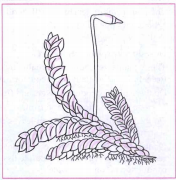Funaria

What do these plants have instead of roots? Solution in Marathi
Step by step video & image solution for Funaria<BR><BR>What do these plants have instead of roots? by Biology experts to help you in doubts & scoring excellent marks in Class 9 exams.
Updated on:21/07/2023Topper's Solved these Questions
Similar Questions
Energy flow through an ecosystem is 'one way'.
View SolutionThe value of |[a,a+d,a+2d] , [a+d,a+2d,a+3d] , [a+2d,a+3d,a+4d]|+|[b
View SolutionAmongst the species Br^(-), Br, Br^(+), the smallest one in size is ________.
View SolutionThe correct order of size among Br^(+), Br, Br^(-)
View Solutionఏ అవయవాలు కవాటాలు కల్గి ఉంటాయి ?br i) గుండెbr ii) ధమనిbr iii) సిరలుbr iV) శోషరస నాళాలు
View Solutionవేర్ల ద్వారా శాఖీయోత్పత్తి జరిపే మొక్కbr i) డాలియాbr ii) ముల్లంగిbr iii) క్యారెట్br iv) క్యాబేజిbr
View SolutionWhat do the symbols : Br,
View SolutionWhat nature roots can be found instead of the main roots of monocotyledonous plants?
View SolutionIn C4 plants, bundle sheath cells are characterised by how many features given below? Br i. Large cells, br ii- Having large number of agranal chloroplasts, br iii- Thin walled
View SolutionWite down the corresponding elements in the figure : 1)……………… br 2)…………… br 3).……………. Br 4)………….. Br 5)…………. Br 6)…………..

View SolutionWhich of the following pairs would have a larger size? Explain.
BrorBr−
View SolutionConsider the following modified structures in plants and select ontogenetically similar structures, br A. Phyllode in Acacia, br B. Thorn in Citrus, br C. Tendril in watermelon, br D. Cladode in Asparagus, br E. Spines in cacti
View SolutionIn C4 plants, bundle sheath cells are characterised by how many features given below? Br i. Large cells, br ii- Having large number of agranal chloroplasts, br iii- Thin walled
View SolutionIn plants, how many of the following symptoms are due to viral infection? Br a- Mosaic formation, br b- Yellowing and vein clearing, br c- Leaf rolling and curling, br d- Dwarfing and stunted growth.
View SolutionIn the given compound, will Br ionize in the form of (a) Br^(-) or (b) Br^(+) .
View SolutionWhich have maximum number of unpaired electrons Br or Br-
View Solution
